
PROGRAM NOTES
The Arirang of Tori: A Korean and American Jazz Collaboration
Listen Now download Subscribe (itunes) Subscribe (rss) help
Program
This concert was made possible, in part, through generous support from the National Museum of Korea and the Arts Council of Korea.
Part I: The Tori Ensemble
Heo Yoon-jeong, geomungo, ajeong, and yang-gum (zithers)
Kang Kwon-soon, jeongga (traditional vocals)
Min Young-chi, daegum (flute) and changgo (drum)
Lee Suk-joo, piri (double-reed)
- The willow is ...
- Meet the heaven
- Fairway song
- Tori, sori, nori
Part II: The Tori Project
The Tori Ensemble, with:
Ned Rothenberg, clarinets and saxophone
Isabel Castellvi, cello
Satoshi Takeishi, percussion and electronics
| Title | Time |
|---|---|
| East: Jeongsun arirang Gangwondo Arirang |
[0:00–12:45] |
| West: Gu arirang; Si-chang | [13:00–21:50] |
| North: Wonsan Arirang | [22:20–44:15] |
| South: Sangju Arirang | [44:20–58:10] |
| Center: Tori Arirang | [58:20–116:15] |
Listen Now download Subscribe (itunes) Subscribe (rss) help
Related Artwork
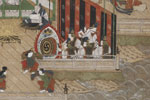
Five Korean musicians perform on ancient instruments that eventually became part of the Japanese court gagaku ensemble. They include a large hanging barrel drum, mouth organ, side-blown flute, and a double-reed instrument (or perhaps an end-blown flute). These instruments began arriving in Japan from Korea in the sixth century, about the time that Korean ambassadors introduced Buddhism to the Japanese.
Detail, Korean Ambassadors Introduce Buddhism to Japan; screen panel (mounted as a hanging scroll); Japan, late 17th�early 18th century; ink and color on paper; Gift of Laurence I. Hewes III in loving memory of Laurence I. Hewes Jr. and Patricia E. Hewes, F1998.308.2
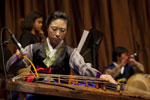
Heo Yoon-jeong is director of the Tori Ensemble and Tori Project. Here she performs on ajaeng (bowed zither) at the Freer|Sackler on December 8, 2011.
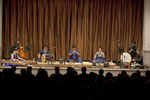
The Tori Project, which performed at the Freer|Sackler on December 8, 2011, featured (left to right) Heo Yoon-jeong, komungo and ajaeng; Isabel Castellvi, cello; Min Young-chi, changgo; Lee Suk-joo, piri; Kang Kwon-soon, vocals; Ned Rothenberg, reeds; and Satoshi Takeshi, percussion.
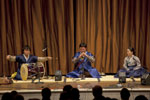
Min Young-chi, changgo (drum); Lee Suk-joo, piri (double-reed); and Kang Kwon-soon, voice, performed with the Tori Project at the Freer|Sackler on December 8, 2011.
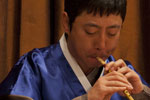
Lee Suk-joo, piri (double-reed), performed at the Freer|Sackler as part of the Tori Project on December 8, 2011
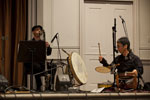
Ned Rothenberg, clarinets and saxophone; and Satoshi Takeishi, percussion and electronics, performed at the Freer|Sackler as part of the Tori Project on December 8, 2011.

Kang Kwon-soon, jeongga (traditional vocals), performed at the Freer|Sackler as part of the Tori Project on December 8, 2011.
Listen Now download Subscribe (itunes) Subscribe (rss) help
Notes
Arirang of Tori
A great many Korean folksongs contain the word “arirang” in their lyrics. As it is performed in the central area of Korea, “Arirang” comes close to being a national folksong. It can be heard today in a great variety of contexts, from a simple duo of vocalist and drummer (changgo) to a full symphony orchestra. It has probably been sung in Korea for centuries, although historical documentation is lacking. The song’s lyrics (see below) employ a traditional vernacular and express love and longing.
The second part of this concert is devoted to the collaborative work “Arirang of Tori.” It is based on the melodic and rhythmic variations of the song typical of five areas of the country: Kangwondo (Gangwondo, east), Sangju (south), Wonsan (north), Seoul (west), and the center of Korea. The Korean word tori refers to the musical dialects and stylistic idioms of these regions. As the name of the group, tori implies a core aesthetic and musical context that offers great diversity and music beyond the boundaries of culture, geography, and history.
In this performance, five distinct versions of “Arirang” are fused with the modern sound of the Tori Project. Each of the seven musicians moves freely between solo and ensemble performance, thus eliminating boundaries imposed between instruments and musical traditions.
—Adapted from notes provided by the Tori Ensemble and from Robert C. Provine, “Folk Song in Korea,” in R. Provine, Y. Tokumaru, and J. L. Witzleben, eds., Garland Encyclopedia of World Music, vol. 7, East Asia: China, Japan, and Korea (New York: Routledge, 2002).
Lyrics
Arirang, Arirang, Arariyo
[The word arirang has no clear meaning, but is generally believed among Koreans to indicate sorrow and sadness. The word itself is found only in traditional music.]
Carrying a bag full of belongings on my back, I am climbing over the hill.
[The narrator expresses the hardships of traveling over an unidentified hill with a heavy bag full of personal belongings.]
Father and mother, come over here, quickly as you can. People say it is a good place to live.
[The lyrics refer to a place called mook-gan-do, which could mean China.]
Although it hurts me so much, I am climbing over Baekdoo Mountain.
[This narrator may need to leave Korea for China, perhaps during wartime.]
Ari-Ari Ssu-ri Ssu-ri, Arariyo
I am climbing over this hill, sadly.
Leaving the place that is fertile, I am now a beggar.
[The fertile land may refer to Korea, an agricultural society. The narrator may be creating a sense of dichotomy between his motherland and the rest of the world.]
The enemy is the one with the guns.
People who can defend for themselves and speak, they will go to the court. If you are strong, you will be assigned to work at the Gong-dong Mountain.
–Translation and comments by intern Hyunjin Chelsey Cho, Wesleyan University, Class of 2013
Listen Now download Subscribe (itunes) Subscribe (rss) help
Performers
The Tori Ensemble transcends musical borders by mingling jazz, new music, and Korean traditions through the musicianship of master Korean artists and leading names from New York’s cutting-edge music scene.
The word tori derives from saturi (dialect), a musical term denoting “local style” in Korean traditional music. The group pursues a new sound that internalizes a variety of tori in traditional music as well as harmonizes with other toris in world music. The term also suggests the surprising diversity of regional music and styles in a country of such small geographical size.
Traditional and jazz musicians reinterpret this diversity in their composed and improvised creations. They focus particularly on improvisation as an important aspect of Korean traditional music, and they often attempt to create a unique language using Asian intuitions and musical idioms.
While based on Korean musical traditions, the music of the Tori Ensemble offers a fresh, new sound to its audiences. This experience broadens appreciation of world music by presenting an ancient tradition within a modern setting.
Founded in 2007 by Heo Yoon-jeong, the Tori Ensemble appeared at the 2010 PAMS (Performing Arts Market Seoul) Showcase and performed at both the opening concert for the 2010 WOMEX (World Music Exposition) and the 2011 WOMAD (World Music and Dance) Showcase. The Tori Project premiered its original concert-length piece Five Directions in 2008 at the Asia Society (New York) and the Freer Gallery of Art (Washington, DC). Subsequent performances were held at the Kay Art Hall, the Stone, Merkin Concert Hall, and Roulette in New York, and in Philadelphia, Utrecht, Amsterdam, and Bremen.
Heo Yoon-jeong, komungo (geomungo), ajaeng, and yang-gum, expands the possibilities of Korean music by fusing traditional, impromptu, and contemporary music in her performances and compositions. She graduated from the National High School of Korean Traditional Music and received her bachelor’s and master’s degrees from Seoul National University. She studied geomungo sanjo with the Living National Treasure Han Gap Duk and earned the master title of yisuja. From 1990 to 1994 Heo served as the deputy concertmaster of the Seoul Metropolitan Korean Music Orchestra. Her collaborations include appearances with German artist Stephan Micus and with the San Jose Chamber Orchestra and the KBS Korean Traditional Music Orchestra, and she has undertaken numerous international tours. She also received a Ministry of Culture prize (1986) and a fellowship from the Asian Cultural Council. Heo is a member of the Sangsang Ensemble, serves as art director of Bukchon Changwoo Theater, leads the project group go-MOON-go, and lectures at Jungang and Yongin universities.
Ned Rothenberg, clarinets and saxophone, has performed internationally for twenty-eight years. In addition to playing the clarinet, bass clarinet, and alto saxophone, he studied the shakuhachi (Japanese bamboo flute) with Katsuya Yokoyama and Goro Yamaguchi. Rothenberg leads the trio Sync, featuring Jerome Harris on guitars and Samir Chatterjee on tabla. Recent recordings include Sync’s Harbinger, Intervals, a double CD of solo work; Live at Roulette with Evan Parker; and Are You Be by R.U.B. (Rothenberg/Kazuhisa Uchihashi/Samm Bennett) on the Animul label. Chamber music releases include Inner Diaspora and Ghost Stories (Tzadik), Power Lines (New World), and The Fell Clutch (Animul). Other collaborators include Paul Dresher, John Zorn, Marc Ribot, Masahiko Sato, Kang Tae Hwan, and Sainkho Namchylak.
Kang Kwon-soon, vocals, is a leading vocalist in both Korean traditional court music (jeongga) and contemporary music. She has performed with the National Orchestra, KBS Traditional Orchestra, Seoul Metropolitan Traditional Orchestra, Kim Duk-soo’s Samulnori Group, and Nan Kye Traditional Ensemble. She has worked under the art directors Ong Keng Sen, Jinhi Kim, and Chen Shi-Zeng. Kang participated in the Melbourne Arts Festival, the Fiftieth Anniversary of Korea’s Liberation, Young Musicians Festival, and the Korea Festival. She also has performed under the auspices of the International Cultural Exchange Foundation of Korea. Kang released Sounds of Heaven, the first CD of Korean traditional court music, in 2004. She has received awards at the Dong-A Competition and the Seoul Traditional Music Festival, sponsored by the Korean Broadcasting System (KBS).
Min Young-chi, taegum (daegum, flute) and changgo (janggo, drum), has performed in Korea and Japan as part of the Korean percussion band Puri and as the music director of Reimei, a traditional Korean art group based in Japan. He has appeared with Chong Myoung-hun, Chong Myoung-wha, Shin Hea-chul, Ssai, Num Goong-yon, Panick, DA PUMP, Shinjuku-Ryouzanpaku, Shanshan Typhoon, Kunihiko Ryo, Eitetsu Hayashi, and Okura Shonosuke, among other bands and musicians. Now making Japan the headquarters for his performances and musical activities, Min directs the group San-Ta (meaning “scattering and hitting”), which is devoted to creating new interpretations of traditional Korean music.
Lee Suk-joo, piri (double-reed), started studying this instrument when he was thirteen years old. His hometown on Jindo Island is well known for its artistic traditions, and Lee was born into a famous musical family that includes Pak Byeong-cheon (Jindo Ssitgim gut, shaman ritual), Lee Yimrye (pansori, narrative singing), and Lee Tae-baek (ajaeng and pansori drummer). Lee is presently a candidate to be named a National Human Property for Jindo Ssitgim gut (Important Intangible Cultural Treasure No. 72) and is the director of the Chungang Korean Traditional Orchestra.
Isabel Castellvi, cello, performs and composes music ranging from classical and contemporary classical to experimental, world, free improvisation, electro-acoustic, folk, rock, hip hop, and avant-garde performance art. She received her master’s degree in contemporary music performance from the Manhattan School of Music and her undergraduate degree from DePaul University. In addition to being the cellist for the ai ensemble, MIVOS Quartet, ThingNY, and Wet Ink Ensemble, she tours and performs with her bands the Bell Cycle, CelloVox, and Copal.
Multidisciplinary collaborations with composers, dancers, and theater and visual artists are an integral part of her work, and she is now studying North Indian classical music.
Satoshi Takeishi, percussion and electronics, was born in Mito, Japan, and studied at the Berklee College of Music in Boston, where he developed an interest in the music of South America. He spent four years in Colombia, where he worked on the project Macumbia–combining traditional, classical, and jazz music–with composer-arranger Francisco Zumaque. Takeishi also performed with the Bogota Symphony Orchestra in a series of concerts honoring the Colombian composer Lucho Bermudes. In 1986 Takeishi returned to Miami and produced the CD Morning Ride for jazz flutist Nestor Torres (Polygram). He has also studied rhythms and melodies of Middle Eastern music with Armenian-American oud (Arab lute) artist Joe Zeytoonian. Since moving to New York in 1991, Takeishi has performed and recorded with Ray Barretto, Carlos “Patato” Valdes, and Marc Johnson.
Listen Now download Subscribe (itunes) Subscribe (rss) help
The Credits
Podcast, notes, and slideshow coordinated by Michael Wilpers, public programs manager. Web design by Liz Cheng and Melda Washington, audio engineering by SuMo Productions and Andy Finch, photography by Neil Greentree, image management by Cory Grace, text editing by Joelle Seligson, and song lyrics translation and comments by Hyunjin Chelsey Cho.. Special thanks to the Tori Project for granting permission to podcast their performance at the Freer|Sackler.
Podcast Series
Concerts
Storytelling
Lectures
Subscribe to this Series
 RSS
RSS iTunes
iTunes
About Podcasts
About podcasting and how to get started
![]() Tell us what you think
Tell us what you think
Radio Asia
Explore music from all across Asia with Radio Asia, a stream of complete tracks from the collections of Smithsonian Global Sound
Most Recent Podcasts
Musicians from Marlboro IMusic of Toru Takemitsu and Tan Dun: Ralph Van Raat, piano
The Legacy of Yatsuhashi
The Traveler’s Ear: Scenes from Music
Western Music in Meiji Japan: Gilles Vonsattel, piano
Western Music in Meiji Japan
The Art of Afghan Music
Painting with Music: Bell Yung, qin
Sounds from Arabia
Tarek Yamani Trio